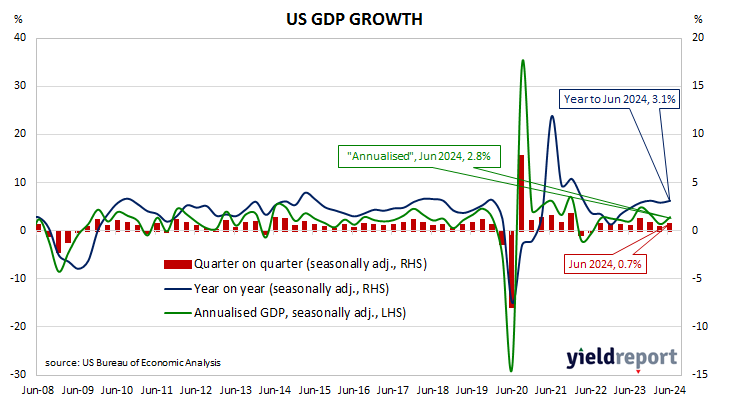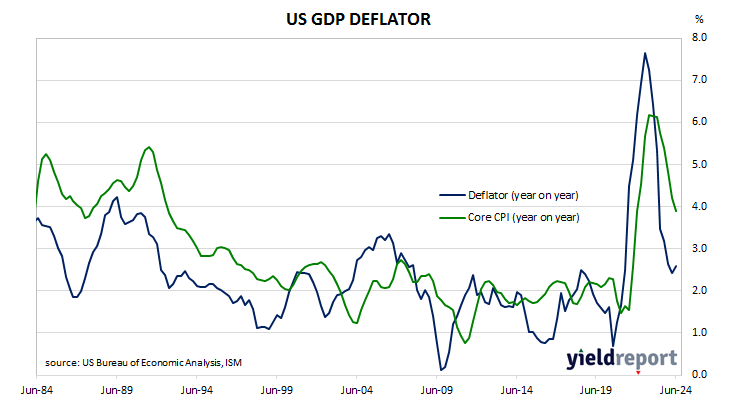Summary: US GDP up 0.7% (2.8% annualised) in June quarter, above expectations; up 3.1% over year; Westpac: data points to goldilocks outcome; US Treasury yields fall; rate-cut expectations firm; Citigroup: caution against extrapolating Q2 strength to coming quarters, expects weakening labour market: GDP price deflator rate accelerates from 2.4% to 2.6%.
US GDP growth slowed in the second quarter of 2019 before stabilising at about 0.5% per quarter. At the same time, US bond yields suggested future growth rates would be below trend. The US Fed agreed and it reduced its federal funds range three times in the second half of 2019. Pandemic restrictions in the June quarter of 2020 sent parts of the US economy into hibernation; the lifting of those same restrictions sparked a rapid recovery which lasted until 2022.
The US Bureau of Economic Analysis has now released the June quarter’s advance GDP estimate and it indicates the US economy expanded by 0.7% or at an annualised rate of 2.8%. The result was greater than the 0.4% increase (1.8% annualised) which had been generally expected as well as the March quarter’s 0.4% rise. On an annual basis, GDP expanded by 3.1%, up from 2.9% in the previous quarter.
“US economic data pointed to a goldilocks outcome,” said Westpac senior economist Pat Bustamante. “Growth was stronger than expected in the June quarter, with the economy growing at around trend over the first half of 2024, while inflationary pressures continue to dissipate towards the Fed’s target of 2%.”
US GDP numbers are published in a manner which is different to most other countries; quarterly figures are compounded to give an annualised figure. In countries such as Australia and the UK, an annual figure is calculated by taking the latest number and comparing it with the figure from the same period in the previous year. The diagram above shows US GDP once it has been expressed in the normal manner, as well as the annualised figure.
US Treasury bond yields fell moderately across the curve on the day despite the higher-than-expected figure. By the close of business, the 2-year Treasury bond yields had lost 4bps to 4.43%, the 10-year yield had shed 5bps to 4.24% while the 30-year yield finished 6bps lower at 4.48%.
In terms of US Fed policy, expectations of a lower federal funds rate in the next 12 months firmed, with five 25bp cuts currently factored in. At the close of business, contracts implied the effective federal funds rate would average 5.31% in August, 2bps less than the current spot rate, 5.20% in September and 4.925% in November. June 2025 contracts implied 4.055%, 128bps less than the current rate.
“Overall, Fed officials will breathe some sigh of relief that final private domestic demand at 2.6% was equally as strong as in Q1,” said Citigroup Global Markets economist Veronica Clark. “But we would caution against extrapolating Q2 strength to coming quarters and continue to expect a weakening labour market that will have Fed officials cutting rates at each consecutive meeting starting in September.”
One part of the report which is often overlooked are the figures regarding the GDP price deflator, which is another measure of inflation. The GDP price deflator is restricted to new, domestically-produced goods and services and it is not based on a fixed basket as is the case for the consumer price index (CPI). The annual rate accelerated from 2.4% to 2.6%.



